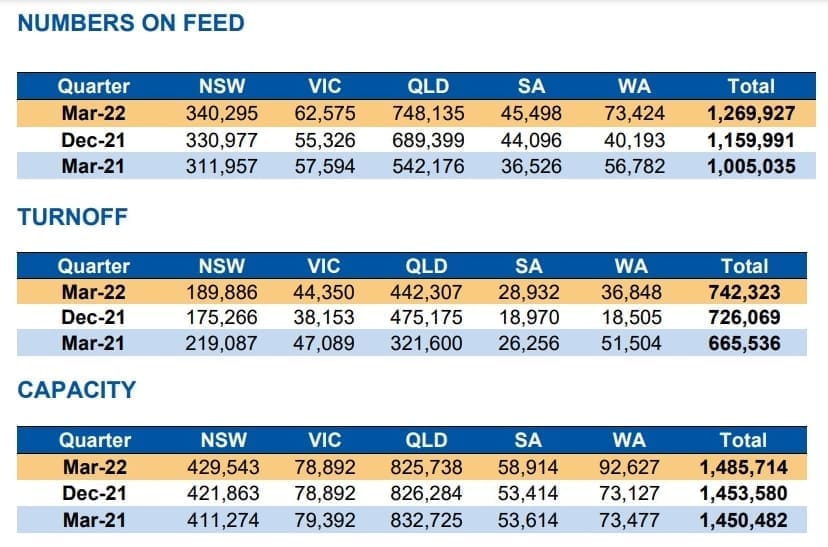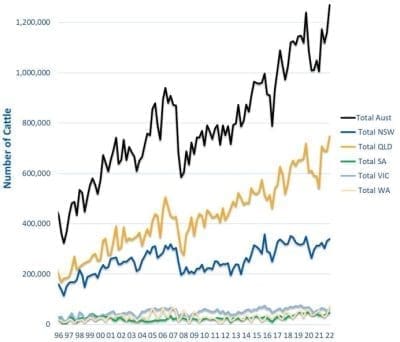BOTH numbers on feed and feedlot capacity across Australia hit new record highs in the March quarter, results from the latest quarterly feedlot industry survey released this morning reveal.
Numbers on feed reached a new record at the time of the survey at the end of March, reaching almost 1.27 million head, an increase of 110,000 head on the December 2021 quarter, and 11pc higher than this time last year.
Last quarter’s numbers on feed figure was 30,364 head higher than the previous record set in the fourth quarter of 2019, when Australia was in the depths of the drought.
Most of the advances in numbers on feed are being seen in mid-sized to larger yards.
Operations in the two smallest categories covering yards up to 1000 head in capacity actually contracted over the past year, while yards 1000-9999 head lifted 21pc in activity, and yards +10,000 head lifted by 264,000 head or 26pc.
With the rapid escalation in feedgrain prices over the past seven weeks, however, some grainfed industry stakeholders believe the peak in feeding numbers may already have been reached, with some yards now reducing numbers due to cost pressures. See earlier report.
Capacity hits new record
Feedlot capacity also reached a new record high last quarter, continuing a consistent trend.
Industry capacity in NFAS-accredited yards in March reached a record 1.485 million head, 35,000 head higher than this time last year.
Australian Lot Feeders Association President Barb Madden said the record numbers of cattle on feed had been achieved in a herd rebuild environment when feeder cattle prices are high and livestock supply is tight.
“Historically, we have seen high cattle on feed numbers coincide with drought periods, however these latest results indicate that the feedlot industry continues to support beef production despite favourable seasonal conditions experienced across most of Australia,” Ms Madden said.
“These latest records point to continued long-term confidence in the grain feeding production system, however lotfeeders are closely monitoring the current strong global grain market and impact COVID has had on commodity supply chain logistics here domestically.”
Feedlot utilisation levels also continue to rise, reaching 85pc nationally in the March quarter, up from 80pc in December 2021.

MLA market information manager Steven Bignell said nationally, feedlot capacity continued to grow incrementally, reinforcing the long-term confidence and investment in the industry.
“Capacity keeps climbing as expansion projects come on-line, and utilisation has remained strong, indicating that lotfeeders have filled the additional pens being built,” he said.
Mr Bignell said Western Australia had the biggest proportional jump last quarter in numbers on feed, increasing by 83pc, in line with WA’s normal seasonal trends during this time of year, while WA capacity increased 27pc as new projects came online.
South Australian feedlot capacity also increased by 10pc in the first three months of the year to 58,914 head.
“The growth in capacity and sustained levels of utilisation, despite high feeder cattle prices, points to the importance the grainfed production system has in Australia’s ability to service demand for high quality Australian beef,” Mr Bignell said.
There was also significant growth in feedlot numbers in Queensland last quarter, with an increase of 58,736 head representing an 8.6pc rise to 748,135 head.
Mr Bignell said the growth in cattle on feed in Queensland showed that despite slaughter and yardings being subdued for the year, producers were still selling cattle to feedlots in large numbers.
That trend is clearly supported by conclusions made in this recent Beef Central article, “Are QLD’s traditional grassfed bullocks under threat of becoming dinosaurs?”




HAVE YOUR SAY